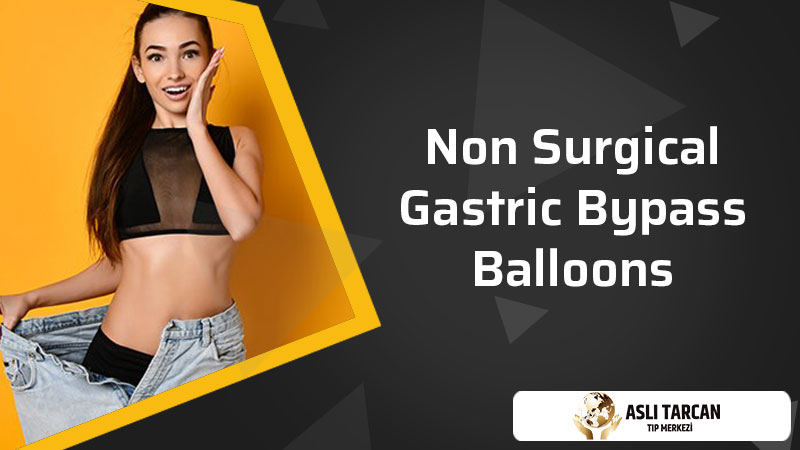Non surgical gastric bypass balloons and gastric bypass treatments can help patients with obesity lose weight. Patients, on the other hand, are torn between the two options when it comes to deciding between them. The findings of an endoscopic examination and blood tests decide whether the operation is best for which patient. Before deciding on surgery, the patient should speak with his doctor and have all of the required tests completed. Sleeve gastrectomy and gastric bypass operations have recently become the most popular procedures for obesity. Both techniques have their benefits and drawbacks. Both treatments should be chosen after thorough study and consultation with a physician.
Non Surgical Gastric Bypass Balloons
A saline-filled silicone balloon is placed in your stomach during an intragastric balloon insertion operation to help you lose weight. This aids weight loss by reducing the amount of food you can consume and making you feel satisfied sooner. If diet and exercise haven’t worked for you and you’re concerned about your weight, intragastric balloon surgery may be an alternative. An intragastric balloon, like other weight-loss treatments, necessitates a commitment to a better lifestyle. To ensure the procedure’s long-term success, you must adopt permanent healthy dietary adjustments and exercise on a regular basis.
The insertion of an intragastric balloon aids weight loss. Weight loss can help you avoid significant weight-related health issues such as gastric reflux disease, heart disease or stroke, excessive blood pressure, and obstructive sleep apnea. Nonalcoholic fatty liver disease, also known as nonalcoholic steatohepatitis, and Type 2 diabetes are two conditions that might be mentioned. Other weight-loss treatments or operations, such as intragastric balloon insertion, are usually done only after you’ve tried to reduce weight by modifying your diet and exercise habits.
Who Is Eligible For Non Surgical Gastric Bypass Balloons?
If your BMI is between 30 and 40, an intragastric balloon may be a viable choice for you. You’re willing to make healthy lifestyle adjustments, see a doctor on a regular basis, and take part in behavioural treatment. You’ve never undergone stomach or esophageal surgery before. For everyone who is overweight, intragastric balloons are not the best option. A screening process will assist your doctor to determine whether the treatment is right for you. At this time, health insurance may not cover the cost of putting and removing the intragastric balloon, therefore it would be an out-of-pocket payment.
One-third of users reported discomfort and nausea immediately after having an orogastric balloon inserting. These symptoms, however, generally only persist a few days after the balloon place. These symptoms are generally treated at home with oral medicines. Serious adverse effects are possible following intragastric balloon implantation, albeit they are uncommon. If you have nausea, vomiting, or stomach discomfort following surgery, call your doctor right once. Deflation of the balloon is a possible concern. There’s a chance that if the balloon deflates, it’ll pass through your digestive system.
This might result in a blockage, necessitating a second operation or surgery to remove the device. Artificial inflation, severe pancreatitis, ulcers, or a hole (perforation) in the stomach wall, all of which may necessitate surgery, are all potential complications. If you are having an orogastric balloon insert into your stomach, your medical team will give you specific instructions on how to prep. Before your treatment, you may need to undergo a series of lab tests and examinations.
Insertion of Non-Surgical Gastric Bypass Balloons
In the days preceding up to the operation, you may need to limit what you eat and drink, as well as which drugs you take. It’s also possible that you’ll require to begin a physical exercise program. The intragastric balloon technique performs as an outpatient operation in the endoscopy unit. For the operation, you’ll anaesthetize. During the operation, the doctor guides a small tube (catheter) down your throat and into your stomach, containing the intragastric balloon. The doctor next inserts an endoscope — a flexible tube with a camera attached — into your stomach and down your neck. Your doctor can watch the balloon as he or she fills it with saline thanks to the webcam.
It takes around a half-hour to complete the operation. You should be able to return home one to two hours after the treatment is complete. Starting around six hours following the surgery, you can consume modest amounts of clear liquids. The liquid diet usually follows until the beginning of the second week when soft foods can introduce. Around three weeks after the intragastric balloon insert, you should be able to resume regular meals. Endoscopes use to remove intragastric balloons after they have been in place for up to 6 months.
Results Of Non-Surgical Gastric Bypass Balloons
Depending on the approach you and your doctor planned, new balloons may or may not grow at that time. Following the operation, you’ll meet with representatives of your team doctor, including your nutritionist and psychologist, on a regular basis. An intragastric inflatable may make you feel filled faster than you normally would do when eating, causing you to take less. One reason for this might be because the intragastric balloon delays the emptying of the stomach. Another reason might be that the balloon appears to alter the levels of appetite-controlling hormones. The amount of weight you lose determine by your ability to alter your lifestyle choices, such as food and exercise.
Even if a weight-loss treatment or surgery works properly, it’s conceivable that you won’t lose much weight or that you’ll gain weight afterwards. If you don’t make the advised lifestyle adjustments, you may gain weight. To avoid regaining weight, you must make permanent healthy dietary adjustments as well as engage in regular physical activity and exercise. The intragastric balloon, like other treatments and operations that lead to considerable weight reduction, may help alleviate or address problems that commonly associate with being overweight.
Obesity procedures occur in a variety of shapes and sizes. It implements by selecting the best appropriate operation or treatment for the individual. The gastric balloon operation is one of them. The gastric balloon technique, which conducts endoscopically, recommend over other procedures since it does not need surgery. Due to the issues created by obesity, people with a BMI of 40 to 35 do not lose weight with diet and exercise. Obesity procedures use in certain situations. Gastric bypass and gastric balloon surgery commonly use by people who desire to lose weight.
The Benefits of Non Surgical Gastric Bypass Balloons
The 12 month gastric balloon and non surgical gastric bypass balloon are excellent for those who want to lose weight quickly and safely. They can offer long-term weight loss results, and minimally invasive procedures that do not require major surgery or extended hospital stays.

Non surgical gastric bypass balloons can not only help with weight loss, but they can also help improve the overall health of an individual. Patients can reduce their risk for heart attack, stroke, and other dangerous conditions such as type 2 diabetes and high blood pressure. Furthermore, these balloons can promote positive lifestyle changes such as healthier eating habits and more physical activity, which can, in turn, lead to lasting results beyond the time spent with the balloon. The fact that this is a non-surgical option makes it even more appealing than traditional gastric bypass surgery. With its relatively low risks and the low chances of having weight gain after gastric balloon, individuals have much potential to benefit from this treatment option significantly.

For those looking to make a permanent change in their lifestyle, non surgical gastric
bypass balloons or twelve month gastric balloon may provide an effective solution for long-term weight loss success. The results that patients see with this procedure often come with improved health markers and better quality of life.


